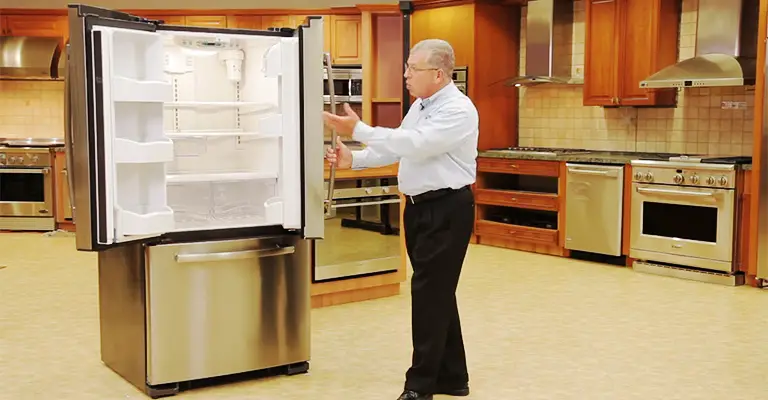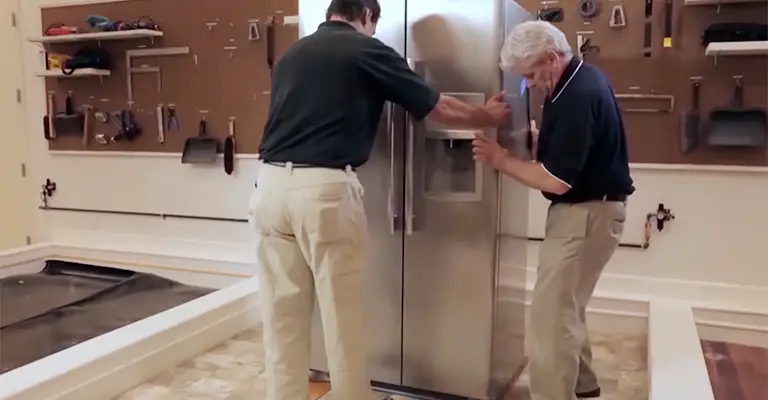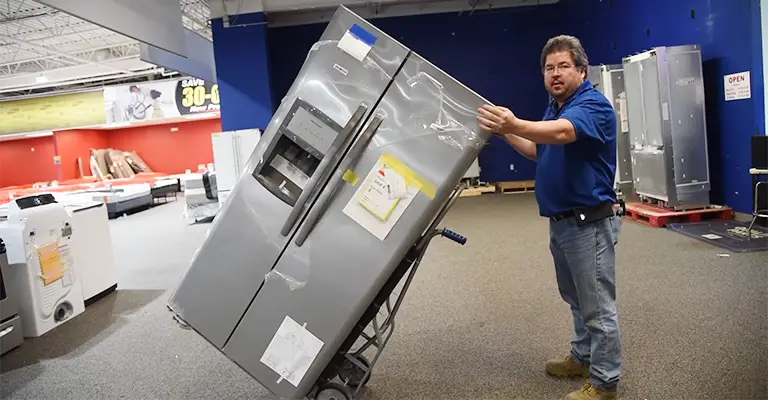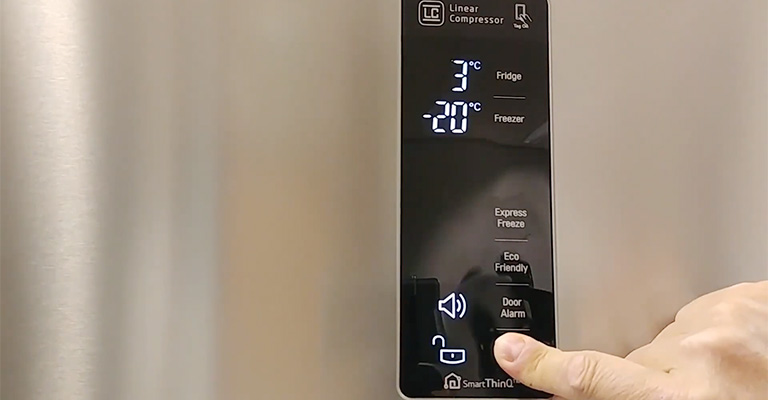French door refrigerators are famous for their spacious interiors, convenient layout, and sleek design. However, if you’re planning to move or transport a French-door refrigerator, you might wonder if it’s safe to transport it on its side.
While it is possible to transport a French door refrigerator on its side, it’s not recommended due to the risk of damage to the cooling system.
In this article, we’ll explore the risks and considerations associated with transporting a French-door refrigerator on its side and provide some tips for doing it as safely as possible.
Handling Transitions: Transporting a French Door Fridge on Its Side

Your refrigerator should remain upright during the whole move, no matter how big it is. Because placing a refrigerator on its side may damage the refrigerator’s compressor, which makes it unable to function.
An oil-filled compressor is held in place by gravity. A flipped fridge can cause oil to flow into the cooling lines and clog them, calling for appliance repair at best or requiring a new refrigerator at worst.
A clogged engine is more likely to cause damage with an older model, which may contain sludge in the oil.
When transporting a French door refrigerator, it’s generally not recommended to do it on its side. In this case, the oil in the compressor can flow into the cooling lines, causing the refrigerator to break down and not cool properly.
To minimize the risk of damage when transporting a French-door refrigerator on its side, follow these steps:
- Make sure all food and shelves are removed from the refrigerator.
- Ensure the refrigerator is unplugged for at least 24 hours to allow the oil to settle back in.
- Use straps or ropes to secure the upright refrigerator.
- It is best to tilt the refrigerator gently and slowly if you have to transport it on its side so that the doors and hinges are not damaged.
- After arriving at your destination, let the refrigerator sit upright for 24 hours before plugging it in to allow the oil to settle back into the compressor.
For instructions on transporting your refrigerator, consult the manufacturer’s website.
When travelling with a refrigerator, it is best to stand it up. The situation might not always allow for this to occur. Although this isn’t preferred, you can move your refrigerator lying on its side.
It’s important to remember that your fridge needs to stand still for hours after it’s been moved. On its side, this wait time could exceed twice the time it would have taken the appliance to lay on its side.
Is It Safe To Move A French Door Refrigerator On Its Side?

Oil from the compressor accumulates in the coolant lines when the refrigerator is horizontal. Having the compressor tube face up can minimize oil leakage if you must move a refrigerator lying down.
Therefore, if the compressor lines run out of the fridge’s right side, bend them to the left. Apart from this, placing a fridge flat on its back is a significant no-no: the weight of the fridge can damage its interior parts, even if they’re not visible.
Certain refrigerator manufacturers warn customers not to move their refrigerators on their side.
The Liebherr compressor brackets, for example, are designed to absorb vibrations from the compressor when the fridge is upright – it can suffer lateral pressure if it is standing sideways.
On the GE website, you can find which models can be turned on their sides and which ones must never be placed horizontally.
Among the models that must remain upright are all French doors, bottom freezers, compacts, and built-in refrigerators. Refer to the manufacturer’s guide or website if you’re unsure about your refrigerator.
Refrigerator Moving Instructions

Whether you transport your refrigerator standing up or on its side, use these tips to avoid headaches.
A box of baking soda or a bit of activated charcoal should be placed inside your refrigerator to absorb odors if it is closed for a long time.
You should take out the drawers and shelves and tape the doors shut. You will be protecting the shelving as well as the refrigerator’s interior, as well as the doors, which can have hinges or corners damaged if the refrigerator opens while in transit.
Before moving your refrigerator, you should unplug and turn it off overnight so it can defrost, though two hours will suffice if you can’t overnight. Ensure that you have an alternate refrigeration source before performing this step if there is any food inside.
How to Turn on A Fridge That’s Been Lying on its Side?

A refrigerator’s compressor can be damaged if plugged in right away after moving it on its side or if it was delivered to your home on its side.
If you’re leaving a refrigerator upright and unplugged, leave it unplugged for the same amount of time it was lying on its side.
It must remain upright and unplugged for two hours if it is on its side for two hours. You should give it a full 24 hours before plugging it in if it was delivered on its side or has been lying sideways for more than a day.
Can You Lay a Fridge Down on its Back if You Pay Attention to the Compressor?
Despite not considering the inner workings of your fridge, there are quite a few reasons why switching fridges on their backs is not a good idea.
Even if you remove all the food and drink from the inside (we can’t imagine the world’s grossest milkshake), drawers, doors, and shelves still have to be addressed.
The shifting that occurs during movement can easily break the glass on refrigerator shelves. The shelves are designed to slide out quickly, and even if you have the refrigerator lying flat on its back, they can shatter or crack when you swing it down.
Also related to this point are refrigerator doors. The vacuum seal between refrigerator doors is not strong enough to keep the doors closed during moving.
It may seem like it wouldn’t be too hard to prevent this by laying the fridge on its back, but it’s also important to consider the direction the compressor line faces.
Relocating and Installing
It may take some time for your fridge to settle in your new home after it is moved into the kitchen. To settle its compressor oil, you should let it stand unplugged, upright, for at least four hours.
The appliance can be plugged in once it has been waiting for 4 hours. The thermostat control should be set to ON but avoid loading food right away.
Cool down your fridge for at least 12 hours before storing food, as it might take up to that time for it to achieve safe temperatures.
Final Words
You can enjoy a cold, refreshing drink within hours of moving your fridge if you move it upright whenever possible to protect its cooling lines and compressor.
When you can’t keep it upright with the hinges at the top, place it on its side with the hinges at the top so the door doesn’t fall. If you have a side-by-side refrigerator freezer, place the freezer side down so the heavier door will stay closed more easily.







